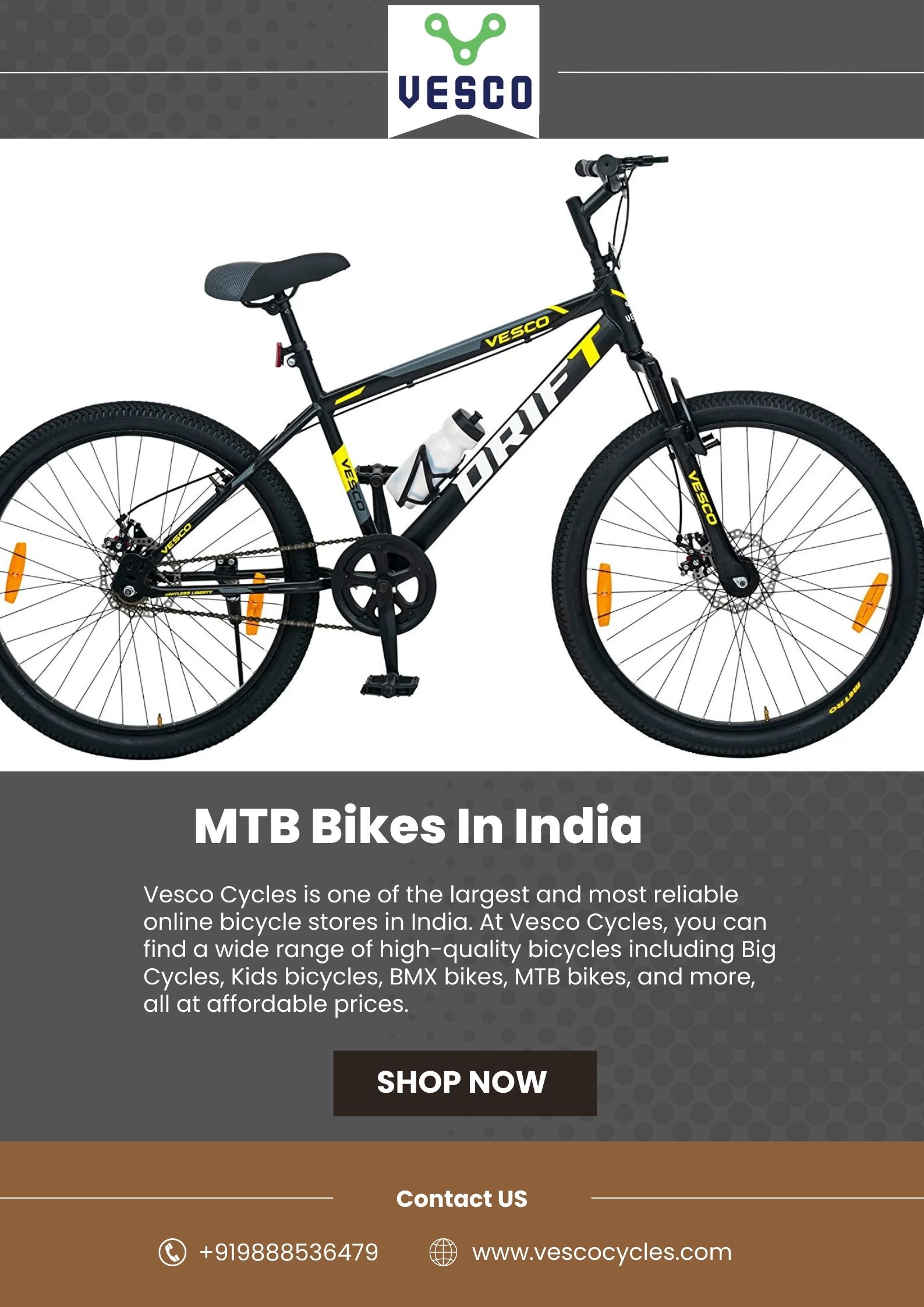Understanding MTB Bikes in India
MTB means “mountain bike.” Mountain bikes are built for off-road cycling on dirt trails, rough paths, forest trails, and steep terrain. MTB bikes are designed for uneven terrain and offer riders control, stability, and durability. India's mountain biking scene is booming. Mountain bikers love the country's varied terrain and stunning scenery. Choosing the proper mountain bike for your needs might be difficult. This article will help you buy a sports and recreation mountain bike in India.
- Bike Type
Choose a mountain bike that suits your riding style and purpose.
- a) Cross-country bikes: These bikes are built for endurance and efficiency on gentler terrain.
- b) Trail bikes are adaptable and suitable for many terrains, balancing climbing, and downhill performance.
- c) Enduro/All-Mountain Bikes: These aggressive bikes are good at tricky descents and climbing.
- d) Downhill Bikes: Great for downhill racing or tough terrain, downhill bikes prioritize stability and suspension above climbing.
- Frame Material
The frame material plays a crucial role in determining the bike's weight, strength, and durability. Common frame materials include:
- a) Aluminum: Lightweight, affordable, and stiff aluminum frames are prevalent among mountain bikes.
- b) Carbon Fiber: Known for its lightweight and high strength, carbon fiber frames offer enhanced shock absorption and stiffness, albeit at a higher price point.
- c) Steel: Steel frames provide a smooth and comfortable ride, with exceptional durability but at the cost of added weight.
- Suspension
Mountain bikes are equipped with either front suspension (hardtail) or dual suspension (full suspension). It depends on your riding terrain:
- a) Hardtail: Hardtail bikes have a suspension fork at the front and a rigid rear. They are suitable for smoother trails, cross-country riding, or those on a tighter budget.
- b) Full Suspension: These bikes feature front and rear suspension, providing enhanced comfort, traction, and control on rough and technical terrains.
- Gearing
The choice of gearing depends on the terrain you intend to ride. Mountain bikes offer a wide range of gear options, including single-speed, 1x (single chainring with multiple rear cogs), and 2x or 3x (multiple chainrings with more gears). Consider your fitness level, intended terrain, and riding style to determine the appropriate gear setup.
- Brakes
Mountain bikes generally come with two types of brakes: rim brakes and disc brakes. Disc brakes offer better-stopping power, reliability, and performance, particularly in wet or muddy conditions. Hydraulic disc brakes are superior to mechanical disc brakes in modulation and precision.
- Fit and Size
Choosing the right frame size is crucial for comfort, control, and efficient pedaling. Consult a size chart or seek assistance from a professional bike shop to ensure you select the appropriate frame size based on your height, leg inseam, and riding preferences.
What are MTB Bikes used for?
MTB, or mountain bikes, are primarily designed for off-road cycling on various terrains and trails. They are versatile and capable of handling rough, uneven, and challenging surfaces. Here are some common uses and activities for which MTB bikes are well-suited:
- Trail Riding: MTB bikes Cycle are popular for trail riding, which involves exploring natural trails, forest paths, and off-road tracks. Riders can enjoy the thrill of navigating through twists, turns, and obstacles while immersing themselves in nature.
- Cross-Country Racing: XC racing involves timed races on off-road trails, typically covering longer distances. XC bikes are designed for efficiency, endurance, and speed, allowing riders to compete in races or engage in competitive events.
- Enduro Riding: Enduro riding combines downhill and cross-country riding elements. Riders tackle technical descents while also navigating uphill sections. Enduro bikes offer a balance of downhill performance and climbing capabilities.
- Downhill Racing: Downhill racing is a high-speed and adrenaline-fueled discipline where riders compete on steep and challenging descents. Downhill bikes are specifically designed for stability, control, and impact absorption during fast descents.
- Freeride and Jumping: MTB bikes are also used for freeride and jumping, which involve performing tricks, jumps, and stunts on purpose-built trails, ramps, or terrain features. Freeride bikes are built to withstand the demands of aerial maneuvers and landings.
- Touring: MTB bikes are well-suited for touring adventures. Riders can load their bikes with camping gear, food, and supplies and embark on multi-day off-road journeys, exploring remote locations and enjoying the outdoors.
- Recreational Riding: Many people use MTB bikes for leisure and recreational activities in parks, nature reserves, or local trails. It provides an opportunity to stay active, enjoy nature, and experience the joy of cycling in off-road environments.
The Takeaway:
When choosing a Mountain Bike for Sports and Recreation in India, consider bike type, frame material, suspension, wheel size, gearing, brakes, fit, and budget. Assessing these factors can help you choose an MTB Bike Cycle that suits your riding style, preferences, and India's varied terrain.







